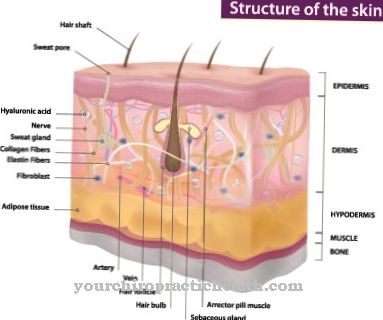In the polymorphic photodermatosis it is a photodermatosis. The skin condition is widespread.
What is Polymorphic Light Dermatosis?

© mouaad - stock.adobe.com
The polymorphic photodermatosis represents the most common skin disease caused by sunlight. It is also popularly referred to as a sun allergy or light allergy, but this is incorrect because these terms do not even exist in medicine. With a share of around 90 percent, polymorphic dermatosis is the most common disease of this type.
Around 10 to 20 percent of the population suffer from it. The female sex is particularly affected by the skin complaints. But the so-called sun allergy often shows up in children and young adults too. There has been an increasing trend in recent years. Polymorphic photodermatosis is not an allergy in the classic sense because there are no typical immune reactions or the formation of antibodies.
In Germany, polymorphic dermatosis is most widespread between March and June, which is due to the climatic conditions. However, photodermatosis can occur at any time when traveling to areas where the sun shines frequently.
causes
The exact causes of polymorphic photodermatosis are still not sufficiently researched. At least it is known that it is not an allergy, although the symptoms of photodermatosis are similar. Polymorphic light dermatosis is always triggered by unusually intense UV-A rays or UV-B rays. In most cases, this happens during the holiday season through excessive sunbathing.
In 75 percent of all affected people, UV-A radiation is responsible for the occurrence of the symptoms. In 10 percent, polymorphic photodermatosis is caused by UV-B rays. The other 15 percent suffer from a combination of both types of radiation.
Some scientists believe that polymorphic light dermatosis is caused by the immune system. There should be a light-sensitive sensor in the skin cells that triggers photodermatosis. Other researchers, on the other hand, believe that there is an imbalance between oxidants and antioxidants within the horn-forming cells in the epidermis.
Because of this imbalance, the people affected are more sensitive to solar radiation. Polymorphic light dermatosis is sometimes caused by the use of certain medications.
Symptoms, ailments & signs
The typical symptoms of polymorphic light dermatosis usually show up with a delay. Symptoms such as itching, burning and reddish spots on the skin only appear a few hours or even days after exposure to the sun. In addition, nodules, blisters, or larger blisters form. In some sufferers, the skin also swells.
The symptoms of polymorphic light dermatosis present differently from person to person. In some patients, the redness can be very pronounced, while others suffer from considerable itching. If a sun allergy occurs repeatedly, the symptoms are usually the same.
The symptoms of polymorphic light dermatosis often show up after prolonged periods of absence from the sun. Therefore, it usually occurs in spring or when visiting the beach. It is typical that the symptoms only appear in areas of the skin that have been exposed to intense solar radiation. Particularly affected areas of the skin are the face, neck, décolleté as well as hands, arms and legs.
Diagnosis & course of disease
If polymorphic photodermatosis recurs, it is advisable to consult a doctor. This first deals with the patient's medical history. He would like to know about the course of the skin problems and on what occasions they occur. In this way he receives valuable information for making the diagnosis.
Other possible reasons for the skin discomfort must also be ruled out. Possible causes are photoallergic eczema or insect bites. For a reliable diagnosis, the doctor irradiates a specific area of the skin with UV light. This can be the upper arm, for example. If a polymorphic photodermatosis is responsible for the symptoms, the typical symptoms are triggered by this photo provocation.
The symptoms of polymorphic light dermatosis usually go away on their own after a few days without leaving any traces on the skin. For this, however, the skin must not be exposed to any further UV radiation. If the skin receives regular contact with the sun, it will get used to the sun's rays over time.
This ultimately weakens the polymorphic photodermatosis so that there are no more skin reactions. If it is a chronic photodermatosis, however, it must be expected again in the following year.
Complications
With this disease, people suffer from various skin conditions. These primarily have a major impact on the patient's aesthetics and can have a negative impact. Furthermore, it can lead to inferiority complexes or a reduced self-esteem. Children in particular can suffer from bullying or teasing with this disease and thereby develop depression or other psychological complaints.
The patient's quality of life is significantly reduced due to the disease. The main result is a burning itch on the skin. Scratching can also lead to bleeding or scarring. Blisters and pustules can also form on the skin and make everyday life difficult. Furthermore, the patients with this disease suffer from a sun allergy, so that the person affected usually has to protect himself from the sun.
The risk of skin cancer is also significantly increased, so that those affected are dependent on regular controls and examinations. Treatment of the disease is symptomatic. Most of the symptoms can be acutely alleviated. Furthermore, treatment with the help of medication can significantly limit and reduce the symptoms. There are usually no complications.
When should you go to the doctor?
If those affected experience changes in the complexion of their skin in sunlight, they should consult a doctor. If there are irregularities after sunbathing or a long walk, we recommend clarifying the symptoms. If skin abnormalities develop at moderate temperatures and a few minutes in the sun, the observations should be discussed with a doctor immediately.
Redness, pustules, swellings or the formation of spots should be examined and treated. If you experience a burning sensation on the skin, an unpleasant itchiness or blistering, you should consult a doctor. If there are nodules or changes in the usual pigmentation, a doctor's visit is advisable. Sterile wound care is required for open wounds.
If this cannot be guaranteed to a sufficient extent, a doctor must be consulted. Otherwise there is a risk of blood poisoning, as germs and other pathogens can enter the organism. This exposes the person concerned to a life-threatening situation that should be avoided. If there are additional emotional or mental problems due to the optical changes, a doctor is also required. Help should be sought in the event of shame, withdrawal behavior, tearfulness or depressive phases. In addition to a doctor's visit, we recommend consulting a therapist so that the general state of health improves as quickly as possible.
Treatment & Therapy
To treat the symptoms caused by polymorphic light dermatosis, cooling the skin with yogurt, quark or buttermilk is recommended. The cooling causes the blood vessels to contract, which causes any swelling to subside. Furthermore, the skin receives urgently needed moisture, which promotes its regeneration.
If the sun allergy is pronounced, the use of medication can make sense. Antihistamines given as tablets or ointments have a soothing effect on itching. Preparations containing cortisone are sometimes given to counteract the inflammation on the skin.
Additional phototherapy is considered helpful. This takes place in spring or before a vacation trip and is used to gradually accustom the skin to the sun through exposure to radiation. The UV radiation exposure is continuously increased.
prevention
Adequate protection from the sun should be ensured so that polymorphic photodermatosis does not occur in the first place. This includes sunscreen with a sun protection factor between 30 and 50, protective clothing and putting on a hat.
Aftercare
In acute cases, polymorphic photodermatosis can be treated with special creams or ointments. These creams should contain corticosteroids such as hydrocortisone. Very severe itching after sunbathing can also be improved by taking antihistamines.
In order to prevent the symptoms of polymorphic light dermatosis, people with sensitive skin should gradually and gradually expose themselves to UV radiation in spring and summer. It is particularly advisable to do this weeks before the summer vacation so that the skin can slowly get used to the sun exposure.
It is also possible to prevent the disease by protecting yourself with broadband sun creams during exposure to the sun. These should be effective against both UVA and UVB rays and have the highest possible sun protection factor. Preparations that contain the antioxidant alpha-glucosyl rutin are also effective.
According to scientific studies, taking food supplements such as vitamin D3 in the form of omega-3 fatty acids can bring about an improvement in the symptoms of polymorphic light dermatosis.
Prophylactic phototherapy can also prevent the development of a sun allergy. This involves repeated whole-body irradiation with blue light of a certain wavelength. A very last step and a method not recommended for treatment is what is known as photochemotherapy. However, this therapy can cause long-term health risks for the patient.
You can do that yourself
The rashes and wheals that occur in polymorphic light dermatosis usually heal without any problems, but they are unattractive and annoying, sometimes even painful. Therefore, the patient will focus on avoiding UV-A light so as not to let the disease develop in the first place. Creams and lotions with a high level of sun protection also help prevent wheals from developing. Should it come to a rash, the affected person can cool the areas. The areas should not be scratched if possible so that the pustules cannot become infected with bacteria. Antihistamines and phototherapy will help prevent further rashes.
In particularly severe cases, the quality of life of those affected suffers considerably. Psychotherapeutic treatment is therefore advisable in similarly severe cases. Those affected also benefit from relaxation techniques. The progressive muscle relaxation according to Jacobson, yoga, Qigong and Tai Chi are recommended. Music therapy can also bring some relief.
For a long time there were no self-help groups for people with polymorphic light dermatosis. It was only in the last few years, when the disease became more common, that self-help groups for people with light allergies were launched. The first of these was the “Lichtblick” group in Schwerte, other groups followed.





.jpg)

















.jpg)



